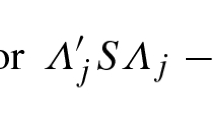Abstract
The issue of factor indeterminacy, and its meaning and significance for factor analysis, has been the subject of considerable debate in recent years. Interestingly, the identical issue was discussed widely in the literature of the late 1920's and early 1930's, but this early discussion was somehow lost or forgotten during the development and popularization of multiple factor analysis. There are strong parallels between the arguments in the early literature, and those which have appeared in recent papers. Here I review the history of this early literature, briefly survey the more recent work, and discuss these parallels where they are especially illuminating.
Similar content being viewed by others
References
Camp, B. H. The converse of Spearman's two-factor theorem.Biometrika, 1932,24, 418–427.
Camp, B. H. Spearman's general factor again.Biometrika, 1934,26, 260–261.
Dodd, S. C. The theory of factors, I.Psychological Review, 1928a,35, 211–234.
Dodd, S. C. The theory of factors, II.Psychological Review, 1928b,35, 261–279.
Garnett, J. C. General ability, cleverness, and purpose.British Journal of Psychology, 1919,9, 345–366.
Garnett, J. C. The single general factor in dissimilar mental measurements.British Journal of Psychology, 1920,10, 242–258.
Gorsuch, R. L.Factor analysis. Philadelphia: Saunders, 1974.
Green, B. F. On the factor score controversy.Psychometrika, 1976,41, 263–266.
Guttman, L. The determinacy of factor score matrices with implications for five other basic problems of common factor theory.British Journal of Statistical Psychology, 1955,8, 65–81.
Guttman, L. “Best possible” systematic estimates of communalities.Psychometrika, 1956,21, 273–285.
Harman, H. H.Modern factor analysis (2nd ed.). Chicago: University of Chicago Press, 1967.
Harris, C. W. On factors and factor scores.Psychometrika, 1967,32, 363–379.
Hart, B., & Spearman, C. General ability, its existence and nature.British Journal of Psychology, 1912,5, 51–84.
Heermann, E. F. The geometry of factorial indeterminancy.Psychometrika, 1964,29, 371–381.
Heermann, E. F. The algebra of factorial indeterminancy.Psychometrika, 1966,31, 539–543.
Heywood, H. B. On finite sequences of real numbers.Proceedings of the Royal Society of London, 1931,134, 486–501.
Holzinger, K. J., & Harman, H. H.Factor analysis. Chicago: University of Chicago Press, 1941.
Irwin, J. O. On the uniqueness of the factorg for general intelligence.British Journal of Psychology, 1932,22, 359–363.
Irwin, J. O. On the indeterminacy in the estimate ofg.British Journal of Psychology, 1935,25, 393–394.
Kestelman, H. The fundamental equation of factor analysis.British Journal of Psychology, Statistical Section, 1952,5, 1–6.
Ledermann, W. The orthogonal transformation of a factorial matrix into itself.Psychometrika, 1938,3, 181–187.
McDonald, R. P. The measurement of factor indeterminacy.Psychometrika, 1974,39, 203–221.
McDonald, R. P., & Burr, E. J. A comparison of four methods of constructing factor scores.Psychometrika, 1967,32, 381–401.
Meyer, E. P. On the relationship between ratio of number of variables to number of factors and factorial indeterminacy.Psychometrika, 1973,38, 375–378.
Mulaik, S. A.The foundations of factor analysis. New York: McGraw-Hill, 1972.
Mulaik, S. A. Comments on ‘the measurement of factorial indeterminacy.’Psychometrika, 1976,41, 249–262.
Mulaik, S. A., & McDonald, R. P. The effect of additional variables on factor indeterminancy in models with a single common factor.Psychometrika, 1978,43, 177–192.
Piaggio, H. T. H. The general factor in Spearman's theory of intelligence.Nature, 1931,127, 56–57.
Piaggio, H. T. H. Three sets of conditions necessary for the existence of ag that is real and unique except in sign.British Journal of Psychology, 1933,24, 88–105.
Piaggio, H. T. H. Approximate general and specific factors without indeterminate parts.British Journal of Psychology, 1935,25, 485–489.
Piaggio, H. T. H., & Dallas, A. E. M. N. An analysis of recent tests of the two-factor theory.British Journal of Psychology, 1934,25, 217–220.
Schönemann, P. H. The minimum average correlation between equivalent sets of uncorrelated factors.Psychometrika, 1971,36, 21–30.
Schönemann, P. H., & Wang, M. M. Some new results on factor indeterminacy.Psychometrika, 1972,37, 61–91.
Schönemann, P. H., & Steiger, J. H. Regression component analysis.British Journal of Mathematical and Statistical Psychology, 1976,29, 175–189.
Schönemann, P. H., & Steiger, J. H. On the validity of indeterminate factor scores.Bulletin of the Psychonomic Society, 1978,12, 287–290.
Spearman, C. General intelligence, objectively determined and measured.American Journal of Psychology, 1904,15, 201–293.
Spearman, C. Correlation between arrays in a table of correlations.Proceedings of the Royal Society, Series A, 1922,101, 94–100.
Spearman, C.The abilities of man. New York: MacMillan, 1927.
Spearman, C. The uniqueness of ‘g’.Journal of Educational Psychology, 1933,24, 106–108.
Spearman, C. The factor theory and its troubles. IV. Uniqueness ofg.Journal of Educational Psychology, 1934,25, 142–153.
Steiger, J. H., The relationship between external variables and indeterminate factors.Psychometrika, 1979,44, 93–97.
Thomson, G. H. A hierarchy without a general factor.British Journal of Psychology, 1916,8, 271–281.
Thomson, G. H. The hierarchy of abilities.British Journal of Psychology, 1919,9, 337–344.
Thomson, G. H. The meaning of ‘i’ in the measurement of ‘g’ (general intelligence).Journal of Educational Psychology, 1935,26, 241–262.
Thurstone, L. L.The vectors of mind. Chicago: University of Chicago Press, 1935.
Thurstone, L. L.Multiple factor analysis. Chicago: University of Chicago Press, 1947.
Williams, J. S. A definition for the common factor model and the elimination of problems of factor score indeterminancy.Psychometrika, 1978,43, 293–306.
Wilson, E. B. Review of ‘The abilities of man, their nature and measurement’ by C. Spearman.Science, 1928a,67, 244–248.
Wilson, E. B. On hierarchical correlation systems.Proceedings of the National Academy of Sciences, 1928b,14, 283–291.
Wilson, E. B. Review of ‘Crossroads in the mind of man: A study of differentiable mental abilities’ by T. L. Kelley.Journal of General Psychology, 1929a,2, 153–169.
Wilson, E. B. Comments on Professor Spearman's note.Journal of Educational Psychology, 1929b,20, 217–223.
Wolfle, D. Factor analysis to 1940.Psychometric Monographs, No. 3, Chicago: University of Chicago Press, 1940.
Author information
Authors and Affiliations
Additional information
Support by the NRC (Grant No. A4640) and the University of British Columbia (UBC Humanities and Social Sciences Grant 26-9508) is gratefully acknowledged.
Rights and permissions
About this article
Cite this article
Steiger, J.H. Factor indeterminacy in the 1930's and the 1970's some interesting parallels. Psychometrika 44, 157–167 (1979). https://doi.org/10.1007/BF02293967
Received:
Revised:
Issue Date:
DOI: https://doi.org/10.1007/BF02293967




